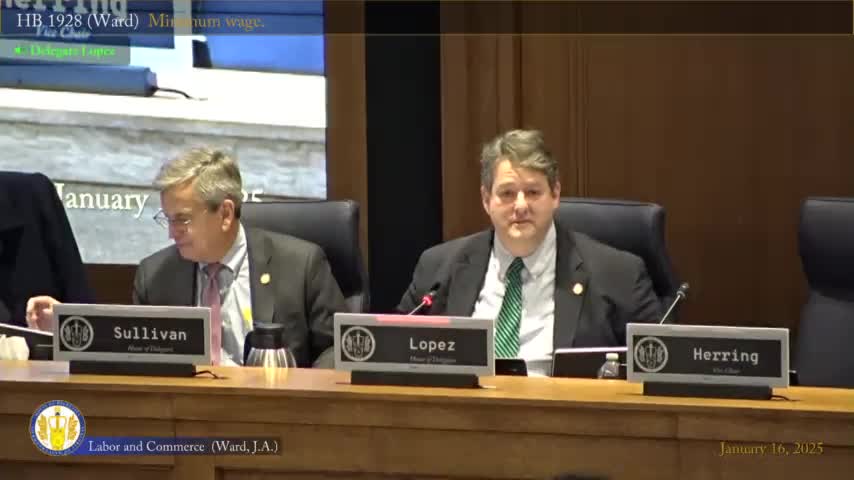Committee narrowly reports bill to raise Virginia minimum wage to Appropriations
January 16, 2025 | 2025 Legislature VA, Virginia
This article was created by AI summarizing key points discussed. AI makes mistakes, so for full details and context, please refer to the video of the full meeting. Please report any errors so we can fix them. Report an error »

The House Committee on Labor and Commerce reported House Bill 1928 to the Appropriations Committee by an 11-9 vote, advancing a measure that would raise Virginia’s minimum hourly wage to $13.50 on Jan. 1, 2026, $15.00 on Jan. 1, 2027, and thereafter tie annual increases to the Consumer Price Index. The bill was presented to the committee during its meeting (date not specified).
The bill’s sponsor said HB 1928 reenacts the statutory reenactment requirement tied to the 2020 minimum-wage law (House Bill 395) and continues scheduled increases that have lifted the state minimum above the federal floor. Under the proposal the state would adopt the federal minimum wage if the federal rate ever exceeded the state rate.
Why it matters: The proposal would raise pay for thousands of low-wage workers across Virginia while drawing opposition from business groups concerned about higher labor costs and hiring. Supporters told the committee the increases would deliver material income gains to full-time minimum-wage workers and boost local spending; opponents warned of wage compression, pressure on small businesses and reduced entry-level hiring.
Committee testimony illustrated the divide. Sophie McGinley of the Commonwealth Institute for Fiscal Analysis said, “The math is simple. When a gallon of milk cost 22% more but wages only went up 3.4%, working families fall behind.” George Krause Meggs, president of the Virginia AFL-CIO, told the committee, “We stand in solidarity for all workers to make at least $15 an hour.”
Business and trade groups opposed the bill. Ethan Betterton of the Virginia Chamber of Commerce said Virginia already “has one of the highest minimum wages among our neighboring and competitor states,” and warned of reduced competitiveness and hiring challenges. Other opponents included the Virginia Retail Federation, manufacturing and agribusiness representatives and chambers of commerce that said higher mandated wages risked price increases and hiring cutbacks.
The committee’s favorable report sends HB 1928 to the Appropriations Committee where budgetary and fiscal impacts will be considered. The measure’s next steps and any amendments will be decided in that committee.
Votes at the committee: Reported and referred to Appropriations, 11 yes, 9 no.
What’s next: Appropriations review of fiscal impacts and any rate-timing or funding amendments.
The bill’s sponsor said HB 1928 reenacts the statutory reenactment requirement tied to the 2020 minimum-wage law (House Bill 395) and continues scheduled increases that have lifted the state minimum above the federal floor. Under the proposal the state would adopt the federal minimum wage if the federal rate ever exceeded the state rate.
Why it matters: The proposal would raise pay for thousands of low-wage workers across Virginia while drawing opposition from business groups concerned about higher labor costs and hiring. Supporters told the committee the increases would deliver material income gains to full-time minimum-wage workers and boost local spending; opponents warned of wage compression, pressure on small businesses and reduced entry-level hiring.
Committee testimony illustrated the divide. Sophie McGinley of the Commonwealth Institute for Fiscal Analysis said, “The math is simple. When a gallon of milk cost 22% more but wages only went up 3.4%, working families fall behind.” George Krause Meggs, president of the Virginia AFL-CIO, told the committee, “We stand in solidarity for all workers to make at least $15 an hour.”
Business and trade groups opposed the bill. Ethan Betterton of the Virginia Chamber of Commerce said Virginia already “has one of the highest minimum wages among our neighboring and competitor states,” and warned of reduced competitiveness and hiring challenges. Other opponents included the Virginia Retail Federation, manufacturing and agribusiness representatives and chambers of commerce that said higher mandated wages risked price increases and hiring cutbacks.
The committee’s favorable report sends HB 1928 to the Appropriations Committee where budgetary and fiscal impacts will be considered. The measure’s next steps and any amendments will be decided in that committee.
Votes at the committee: Reported and referred to Appropriations, 11 yes, 9 no.
What’s next: Appropriations review of fiscal impacts and any rate-timing or funding amendments.
View full meeting
This article is based on a recent meeting—watch the full video and explore the complete transcript for deeper insights into the discussion.
View full meeting
